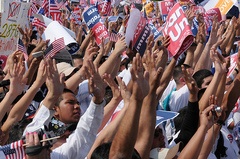VOICES: Did Sunday's immigration march do any good?
 By Marisa Trevino, LatinaLista
By Marisa Trevino, LatinaListaThe hope of the march was to remind the President that the Latino community had not forgotten his campaign promises to reform immigration policy. Plus, it was to show Congress that even a small fraction of the Latino community can make a lot of noise.
Yet, with all (media) eyes focused on the congressional theatrics leading up to passage of the healthcare bill and undue attention given to a small group of Tea Party protesters on Capitol Hill, after some in their group unleashed their special warped brand of patriotism against some gay and Democratic politicians of color, the 200,000-500,000 immigration reform marchers were hardly seen or heard of in the mainstream media.
It's a safe bet that the President and his inner circle had their eyes tuned to C-Span watching events unfold in the House of Representatives rather than paying too much attention on what was happening outside the gates of the White House.
So, as the marchers head home, the big question that remains to be answered in the weeks to come is: Did this march do any good?
Though the images and coverage of yesterday's march aren't as impressive as those from marches of the past, the march was a success for one very fundamental reason -- it illustrates how far the Latino community has come in terms of, not just fighting for something, but in learning how to do it.
The criticism still stings of those early images when young people, in their enthusiasm to stand up and be recognized, were toting flags from every other country other than the United States.
To people unfamiliar with the daily reality of first and second-generation Latinos who are proud of two countries simultaneously -- their "root" country and the country they call home -- the display of other flags was misunderstood.
It was a hard lesson learned, but learnt nonetheless, as illustrated by yesterday's march.
With each march and each call to action to fight for immigration reform, the Latino community is learning lessons in civics that have been long forgotten by the majority of the constituency that has become either complacent or lazy, and where it has become a foreign concept that people march for what they believe in.
Rather, the preferred way to protest seems to hunker down in small groups and hurl insults at the opposition who have the misfortune to pass too closely to them.
That's not democracy in action -- it's more like the showdown for a turf fight.
When the time comes when all Latinos in this country are citizens, the lessons learned from these days of marches will be expanded upon but never forgotten.
Because if one thing was learned in yesterday's march, it doesn't matter how many media cameras are present but how many marchers' voices are raised in unison.
Marisa Trevino is based in Dallas, Texas and is founder and editor of LatinaLista, where a version of this originally appeared.